In a world where experimental electronic music exponentially splinters into a multitude of rogue genres that slowly shuffle the globe from demilitarized dance floors to sleeper cell bedroom studios and back, a team of disparate scientists tracks this solanum-like pandemic while desperately trying to interpret cryptic field recordings of Samhain’s past, not one day at a time, but from Amen to Zombie…
Zombie
This week we see the reboot of a franchise that has a special place in my heart. Bring it, back come rewind to the year 1988. A watershed year for culture, for me at least. I was entering the fourth grade, had recently discovered hip hop (don’t hate just cause the first tape you bought was Slippery When Wet and mine was 3 Feet High and Rising) and skateboarding. Toys were amazing (see: Transformers G1 and Neon Leon) and all was right with my tree fort. Summer was spent in a haze of Skyscraper candy bars from the snack shak at the community pool and running across scorching tennis courts to steal tennis balls to go play run-down with.
Just as August was cooling off East Pittsburgh, there appeared a new commercial on TV. One with a familiar face and title that I had heard before, but really wasn’t sure to believe was true or not. Did someone really make a movie about a guy in a red/black sweater that could kill you in your sleep? This was the sort of thing that seemed to be designed to scare the crap out of me. But naw, that was all bunk, it was just my friends trying to trick me But sure enough:

BOOM! As the summer blockbuster season steamrolled on, and there was nothing to do some days before YO! came on at 5:00, there is was on my TV screen. The trailer for the new A Nightmare on Elm Street movie. It was then that I learned that yes, someone had indeed made a movie about killing girls that were my babysitter’s age in their sleep. And it scared the crap out of me. I couldn’t even watch the commercial. It seemed like the worst possible scenario: someone could kill you in your sleep while you were dreaming. End of story.
In some of the other horror movies I had sneaked peeks at when I was a kid, there seemed to be simple solutions. Poltergeist: just move. Halloween: just move, quickly and during the day. The Wraith: stop drag racing. Simple solutions. Dealing with Freddy Krueger? My 9-year-old mind couldn’t even fathom it.
It would be years and years before I ever watched a Nightmare on Elm Street movie. Partially due to my flashbulb memory of the commercial and partially due to the very nature of horror being evoked. A terror that no one could hide from, it affected everyone the same. If you pissed Freddy off, you were done. Everyone has to sleep, and now that some scientists have expanded the definition of dream to dream mentation — meaning any mental activity during sleep — we are doubly screwed this time around as the reboot occurs. (For a lengthy discussion on the dream part of ANoES, page me. I’m a sleep researcher.)
So calling a timely audible, I thought it might be cool to check out some of the music of the ANoES oeuvre. Not necessarily related to Halloween music, but still within the same ballpark. I could easily write a blog on exploring the soundtracks and BGM of horror/sci-fi/action movies. And I’m sure they exist elsewhere. Page me if you find any good ones.
The Dream Master (ANoES 4) features this video. Yeah, The Fat Boys and Freddy. Rapping. Together. To my 9-year-old mind this was evidence that Freddy was coming to get me. He would slowly invade the things that I liked, then my dreams, then kill me. I wasn’t really into The Fat Boys, but it seemed that that would be Freddy’s game plan. Get into rap on the edges and then do battle with EPMD before he got to me.
Actually, that Fat Boys track was a marketing promotion to try and drive ticket sales. The track isn’t on the soundtrack, but Blondie is. Go figure. Along with a bunch of other crap that’s not worth mentioning. A “Film Score” was released on Varèse Sarabande which we’ll get to later. Let’s take a look at the next in the series.

Here we have both the cover of the Original Soundtrack and the movie poster for The Dream Child. That sweet artwork is by Matthew Joseph Peak. I think that it has just as much to do with my terror of this series as the contents of the movie. By the time Freddy’s Dead came out I was old enough to actually sneak into one of the ANoES movies, but the poster sucked. Nothing like Peak’s fantasy-scapes, always containing Freddy’s eye peering at you from the beyond. Although if you check out Freddy’s Favorites released by Varese Sarabande you can see a sixth Peak image that follows the artwork from the original and it’s not the lame-o 90’s style artwork that was on the U.S. theatrical poster.
The film score also has the cool Peak artwork, but we’ll stay in the 80’s. The first 5 ANoES movies came between ’84 and ’89 and I think are the aweseomest. And for two reasons: 1) the Freddy’s Dead movie strays from the “dream” theme for the subtitle and does away with the ANoES title (technically the movies are part of the ANoES saga, and are thematically and chronologically linked). 2) The Goo Goo Dolls are on the soundtrack. Three times. The Dream Master at least had Kool Moe Dee and Schooly D. The Dream Child had Freddy skateboarding in the flick, thus claiming another of my favorite 4th grade pastimes.
Let’s move forward, by moving back:
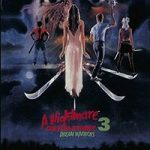
The Dream Warriors (ANoES 3) is probably where I first heard about Freddy, but I don’t have much memory of watching the commercial or seeing it on USA in middle school. Although I do vaguely remember the poster. The plot finds Freddy’s victims going to sleep on purpose to do battle with him. Not a smart move. But now that I myself am a sleep researcher, this is the one I want to go back and re-visit the most.
As far as soundtracks, here is where the huge rift between the “good” (read: film score) soundtracks and the “bad” (read: soundtrack with crappy pop music meant to drive ticket sales) begins. And you have Dokken to blame. Due to the nice little 45 Dokken put out for The Dream Warriors, every subsequent ANoES movie HAD to have a pop music component. Thus making the film score recordings even harder to find. Who wants a record with some ’80’s electro-Vangelis-meets-horror-movie-pastiche on it? Me, that’s who.

Freddy’s Revenge (ANoES 2) I have not seen or heard any of the soundtrack. However, it is talked about as the worst of the series not only by Freddy himself (Robert England A.K.A Freddy Krueger has been quoted saying that ANoES 2 & 5 were his least favorites), but by fans as well. It is also talked about for being homoerotic in it’s characterization of one of the leads. This could be a very lengthy post about how a horror film based in both the dream world and the real is such fertile ground for not only the authors and creators, but interpretation that your head might explode, but let’s stick to the music. Which I think reflects its subject matter as all good scores/BGM should.
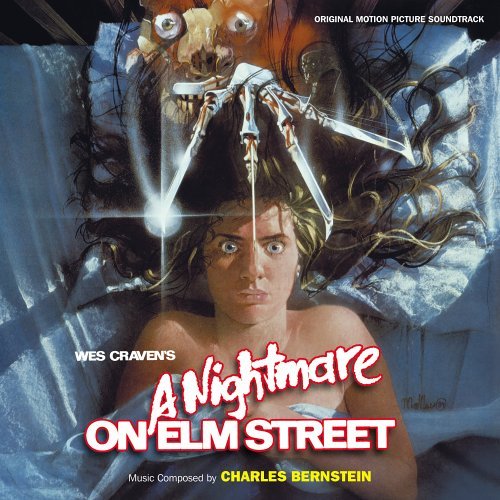
Tracks:
01. Prologue
02. Main Title
03. Laying the Traps
04. Dream Attack
05. Rod Hanged – Night Stalking
06. Jail Cell
07. Confrontation
08. Sleep Clinic
09. Terror in the Tub
10. No Escape
11. School Horror – Stay Awake
12. Lurking
13. Telephone Terror
14. Fountain of Blood
15. Evil Freddy
16. Final Search
17. Run Nancy
As I said before, we’ll get to Varese Sarabande. The label started out in ’72 as a avant garde classical label. Now they’re one of the largest back catalogs of original film scores. Possibly the biggest in the world. Here’s some of the film titles they’ve released original motion picture soundtracks for: Mad Max, Escape from New York, Videodrome, The Evil Dead, Spies Like Us, Blue Velvet, and of course A Nightmare on Elm Street. The back catalog is insane when you look at it. I would imagine that every time you said something like “that’s (insert adjective) BGM in that movie” it was probably issued as an original motion picture soundtrack on Varese Sarabande. Here we have Charles Bernstein doing his best to creep the audience out with his electro-acoustic score.
Once you hear the opening eight-note leitmotif that makes up the movie’s main theme in “Prologue” and “Main Theme” you’ll be transported to that world. The instrumentation stays pretty close to the piano/synth/drum machine power trio that is characteristic of these types of scores. With the occasional human voice thrown in, and in some cases heavily effected. There is a low ebb of bass notes gently effected by an LFO that provide the audio fog at your feet. Ethereal voices from the synth yawn like ghosts trapped in those machines. Evil dub drums echo though damp night streets. More synths twinkle like halogen lights at 4 am parking lots. Rogue synths squelch and blurp out organic alien sounds. Corrugated steel siding is the voice of a rapid, but not too rapid, drum machine roll. Perfect atmospherics for a horror movie in my opinion.
Two synth notes, slightly out of tune, screech at one another back and forth, reminding us of our constant path back and forth from the dream world to the waking. In “Layering the Traps” we get the getting-prepped-for-the-shit-to-go-down montage swagger of a guitar riffing. And in “Dream Attack” we get the 8-bit pitch of boss music. There are other frantic pieces of music on the soundtrack, but slow tension is what most of the music tries to convey.
Most noteworthy of this slow tension, is the absence, or almost complete absence of “the sting.” “The sting” is the term John Carpenter used to describe that kind of orchestra hit that occurs just as the killer jumps out at you. There are not a lot of those cheap thrills in this soundtrack. That’s not to say that there isn’t any musical punctuation. “No Escape” is full of weird synth sounds bubbling and blasting around a 4/4 kick/kick/snare/snare groove. But there is no full stop, no “sting.” The closest Bernstein comes is at the end of “Main Title” and it’s kind of weak as far as stings go. And you can imagine that after the opening credits, we’d be privy to some inside dialog as the story starts to unfold. So a flourish would be a more apt description.
This slow synth tension is what I absolutely love about the soundtrack. It’s also what makes these types of movie soundtracks predictable to some people. I have to admit this piece actually started out as a book review on a scientific book that I came across in my professional career. The book was from the early ’70s and was really bugging me out when I started to read it. There were cool theoretical things in it, like if growing scientific evidence on dreams and their meaning would mean that we could somehow control people by understanding their dreams. There’s also a chapter devoted to the nightmare. In it the authors state that most “night terrors” occur in the deepest sleep.
Now, for those who don’t know, delta sleep, Stage 3 (no more Stage 4, it’s the same as Stage 3 and mostly a sleep scoring issue), or deep sleep is where these dreams that we are not conscious of can occur. Kids sleep walk in deep sleep. If you’ve ever looked at an EEG tracing of your brain while you were in deep sleep (check out ANoES sleep lab scenes; all that shit is legit) it would look like slow synchronous sine waves.
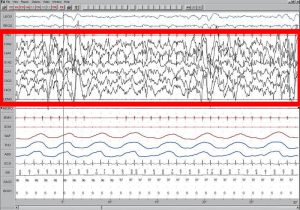
Maybe the way you might expect one of those creepy synth lines to be displayed by an oscilloscope to look like? That is if you could print out what the oscilloscope was doing on a piece of paper. It’s interesting that Berenstein chooses this very controlled back-and-forth in his score. The end of “Sleep Clinic” rushes us out of the piece, as the beginning lulls us into the piece. Some tracks are even split in half, “School Horror/Stay Awake” for example, yet there is no real clear-cut distinction where one track ends and the other begins.
“Terror in the Tub” starts off as somber synth tones that are almost sci-fi in their feel, then “Sleep Attack” is pitched down and reprised. The track is exactly one minute long and has somber synth and chase in equal parts, 30 seconds apiece. I think a very controlled and masterful use of the idea that sleep is our other reality, our other half. However, we are of sleep. And its reality. We are not beyond the sleep world and there is no substantial evidence that this world is indeed real. Nor is there substantial evidence that our waking world is real. So our days are a slow controlled ebb and flow from sleep to wake to sleep. And maybe that’s why those slow rise and fade synth tones fit this movie so well.
The other idea I had for this post concerned hypnogogic pop. I don’t want to go into a description of it — Google is your friend — but I want to make it clear, if I haven’t already, by my thoughts on the soundtrack, that I wholeheartedly and head-idly enjoy this music as well as all the other Halloween music I’ve written about here. As I understand it, hypnogogic pop is music that is trying to relive the 80’s in the most ironic, cynical way possible. Under the adjective of hypnogogic, which means “around sleep,” people are taking things like “Lady in Red,” slowing it down into this dreamy sludge of nostalgia that seems to ride the line between lazy pastiche and the fascination that slowing things down makes them “dreamy” or “forlorn.”
My intent is not to discus hypnogogic pop or define its terms. I do want to address the issue of looking back at something like the ANoES soundtrack and saying “Remember… that was so stupid, its great.” Which is a bit of where I think we are at in terms of music culture nowadays. There seems to be no sampling from the past to perform some sort of magic alchemy or trying to unlock the magic in a piece of music or sound with so much of the music nowadays. Yet everyone one is obsessed with reconfiguring the past in music. Maybe we’re entering an age of the end of new culture.
I am as serious about listening to Halloween as I am if I were listening to musique concrete. And I love both, no irony involved. And I invite you to pick up the ANoES soundtrack and have a listen with open ears. Take it out on a long midnight walk and see what it does to your psyche. Whatever your landscape I’m sure that it will haunt it. And there’s the magic in pieces of spooky music. It can still do its job regardless of what machines are designing the sound of it. I can’t wait to see the remake of ANoES this weekend and hear what they’ve done to update sound of slow terror. It’s a dream come true.
Goodnight out there, whatever you are.



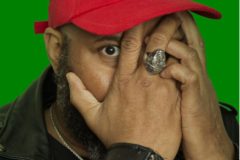


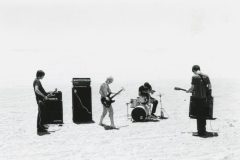

Social Media